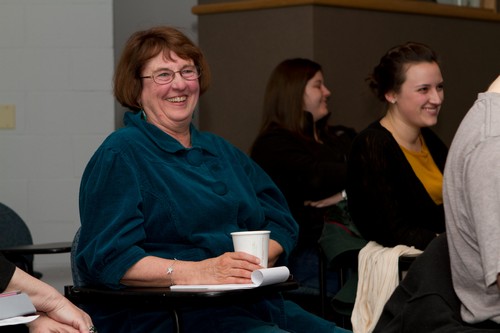 Photo by: Ross Edfort
Photo by: Ross Edfort
Think art is an easy major? Students of the harder sciences may scoff at Art History as a stress-free discipline.
In truth, the Art History faculty at DU has made strides to create a nurturing refuge in an extremely competitive field, by hosting events such as the School of Art and Art History Symposium.
A dedicated group of professors and students in the School of Art and Art History gathered in the Shwayder Art Building last Friday for the 11th annual symposium that offered a forum for graduate students to showcase their research and solicit feedback.
Students presented their papers, accompanied by slide-shows. Each presentation was followed by questions and animated discussions.
According to Medieval Art professor Scott Montgomery, the event was about exposing students to the reality of scholarship beyond graduate school.
“It’s preparing them for the craft and practice of the discipline [of Art History]. There’s nothing like a professional deadline to help hone a paper,” said Montgomery.
Montgomery sympathized with the anxiety often felt by students when presenting research for the first time.
“The thing that terrifies people is taking questions on their paper. One needs to learn how to field unanticipated questions; it’s like verbal tai-chi,”said Montgomery.
DU’s Art History symposium is unique among many universities.
The opportunity to present one’s work first in a smaller, friendlier and more mentoring atmosphere is rare, said Montgomery.
He compared the DU symposium to more well-known events such as the Frick Talk in New York City, which provides a similar venue for graduate students in Art History to present their work.
“The Frick Talk is much more intense and contentious. It is highly competitive. I like that I see no difference in the quality of what we do here and what’s done there, but we foster a more collegiate environment that isn’t discordant,” said Montgomery.
Many of the papers presented at the DU symposium dealt with topics in Meso-American art and how certain works can be used to gain a better understanding of the cultural changes indigenous people went through after the Spanish landed on their shores. Another paper dealt with a Western painter’s interpretation of a Buddhist goddess in Japan.
The symposium offered only a small sample of the wide range of scholarship occurring within the Art History graduate department.
While students gain new exposure, Montgomery mentioned the professors gain new perspectives on their students.
“We get to know students through their work outside our classes. It’s also interesting to see how our classes influence what they do. It’s the sign of a successful class when four [of the papers presented] are related to the topic of that class,” said Montgomery.
Of all the papers presented at the DU symposium, one is selected for presentation at the state-wide level in the Front Range Art History Student Symposium.
However, Montgomery stressed that DU’s symposium thrives because of its non-competitive nature.
“In selecting one paper to present, I feel we’re creating a sense of unity. It’s a celebration of Art History in Colorado,” said Montgomery.











